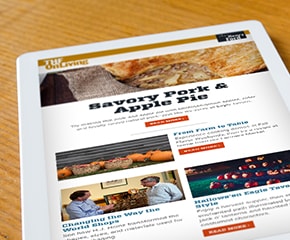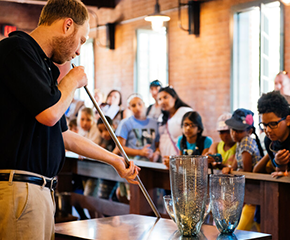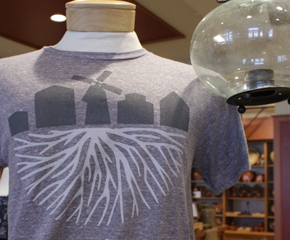
Dave Friedman Collection
Photographs, slides, negatives, documents, programs and published material covering 60 years of automobile racing.
Biographical / Historical Note
The son of a movie producer and silent film actress, Dave Friedman spent most of his professional career as a still photographer on many well-known film productions. After service in the U.S. Navy, Friedman began attending and photographing local amateur...
MoreThe son of a movie producer and silent film actress, Dave Friedman spent most of his professional career as a still photographer on many well-known film productions. After service in the U.S. Navy, Friedman began attending and photographing local amateur sports car races around his native Los Angeles, continuing a lifelong passion for photography. At these races, Friedman met young drivers such as Carroll Shelby who, while hurtling small, powerful sports cars around hay bales on airstrips and parking lots, were in the process of defining a new professional racing sport and industry. In 1963, Carroll Shelby hired Friedman to document the design and development of what would become one of racing's most dominant stables of cars: the Shelby Cobra, King Cobra and Cobra Daytona coupe.
In 1965, Friedman started at 20th Century Fox as an assistant cameraman. While at the studio, he continued to document the growing popularity of auto racing at legendary tracks such as Laguna Seca and Riverside International Raceway. Friedman also continued his relationship with Shelby's racing teams, attending three of the biggest endurance races in sports car racing: the 24 Hours of Daytona, 12 Hours of Sebring and 24 Hours of Le Mans. Friedman captured the final development of the first American-designed and built racecars that dominated the grueling 24 Hours of Le Mans race between 1966 and 1969. In 1969, Dave Friedman changed his focus again and became a still photographer for film productions, where he continued to capture iconic images of American cinema and television.
Dave Friedman has written over 30 books on automobile racing, covering a variety of classes including sports car road racing, Formula 1, Can-Am, Trans-Am, drag racing and stock cars. In recognition of his professional accomplishments, Friedman is the only still photographer elected to the Motion Picture Academy of Arts and Sciences. Friedman continued to pursue his passion for motor sports into the 1990s, when he refocused his lens on a different art form – classical ballet.
LessScope and Content Note
The Dave Friedman collection documents over 60 years of various automobile races and racecars and includes photographs, slides, negatives and contact sheets. In addition, the collection includes files that detail specific races, including such information...
MoreThe Dave Friedman collection documents over 60 years of various automobile races and racecars and includes photographs, slides, negatives and contact sheets. In addition, the collection includes files that detail specific races, including such information as entrant lists, car details, programs, press kits, and published materials. The collection also includes material related to racing teams and manufacturers including Ford Motor Company, Shelby-American International, Dan Gurney's All-American Racing, Jim Hall's Chaparral Racing, Corvette, Ferrari and Porsche. Material in this collection was used by Dave Friedman to illustrate over 30 books about automobile racing.
The Dave Friedman Collection is made up of two subgroups; the PHOTOGRAPHS SUBGROUP and the RESEARCH FILES, PROGRAMS AND OTHER MATERIALS SUBGROUP.
The PHOTOGRAPHS SUBGROUP, 1948-1999, is comprised of four series: the Digital Images series, the Negatives and Contact Sheets series, the Prints series, and the Slides series. The Photographs subgroup encompasses an array of races, racecars, drivers and teams and includes images of races at tracks across the United States and around the world. The subgroup includes photographic prints, negatives, digital files, contact sheets and slides. Race name, track, race date and driver information are identified on the back of most prints. Images with no identifying data are filed in each series or subseries as "Unidentified."
The Digital Images series, 1959-1995, is an incomplete set of digitally scanned negatives found in the General subseries of the Negatives and Contact Sheets series. Some races are available online at http://www.flickr.com/photos/thehenryford/collections/72157628488413505/
The Negatives and Contact Sheets series, 1951-1995, is made up of three subseries. The General subseries, 1951-1995, consists of black-and-white negatives and contact sheets covering a wide variety of sports car, endurance, Formula 1, Can-Am, Trans-Am and stock car races. The negatives include 35mm and larger formats. An asterisk (*) indicates that negative images for that race can also be found in the Digital Images series. The subseries is arranged chronologically and then by race. The Indianapolis 500 subseries, 1963-1969, contains black-and-white negatives and contact sheets covering the Indianapolis 500 and is arranged chronologically. The Shelby-American International subseries, 1958-1968 contains negatives documenting Carroll Shelby's racing career as well as the design, construction and races of noted Shelby-American cars including the Shelby Cobra and King Cobra and various Ford Mustangs and specialty prototype racecars such as the Ford GT cars including the Mark II and Mark IV. The Color negatives subseries, 1962-1978, is made up of 35mm color negative film strips.
The Slides series, 1959-1999, is made up of three subseries. The General racing subseries, 1959-1999, consists of 35mm black-and-white slides covering various races and race types, including vintage races featuring restored race cars. The Indianapolis 500 subseries, 1961-1969, consists of 35mm color and black-and-white slides documenting the Indianapolis 500 race.
LessCollection Details
Object ID: 2009.158.0
Creator: Friedman, Dave
Inclusive Dates: 1946-2009
Bulk Dates: 1960-1995
Size: 64.6 cubic ft., 93 negative binder boxes, 5 oversize boxes, and 100,000 digital images
Language: English
Collection Access & Use
Item Location: Not Currently On Exhibit
Access Restrictions: The collection is open for research.
Credit: From the Collections of The Henry Ford.
Keywords
Digitized Artifacts From This Collection
In many cases, not all artifacts have been digitized.
Contact us for more information about this collection.

Bill Krause in Shelby Cobra at 3-Hour Endurance Race, Riverside, California, October 13, 1962
 Details
Details
Bill Krause in Shelby Cobra at 3-Hour Endurance Race, Riverside, California, October 13, 1962
Artifact
Negative (Photograph)
Date Made
13 October 1962
Creators
Object ID
2009.158.N.621015.19
Credit
From the Collections of The Henry Ford.
Location
By Request in the Benson Ford Research Center
Get more details in Digital Collections at:
Bill Krause in Shelby Cobra at 3-Hour Endurance Race, Riverside, California, October 13, 1962
What is The Henry Ford?
The national attraction for discovering your ingenuity while exploring America’s spirit of innovation. There is always much to see and do at The Henry Ford.
Indianapolis 500, May 1962
Artifact
Negative (Photograph)
Creators
Keywords
Object ID
2009.158.N.620505.12
Credit
From the Collections of The Henry Ford.
Location
By Request in the Benson Ford Research Center
Get more details in Digital Collections at:
Indianapolis 500, May 1962
What is The Henry Ford?
The national attraction for discovering your ingenuity while exploring America’s spirit of innovation. There is always much to see and do at The Henry Ford.
Indianapolis 500, May 1962
Artifact
Negative (Photograph)
Summary
With sponsorship from Los Angeles-based Harvey Aluminum, Mickey Thompson took three cars to the 1962 Indianapolis 500. All were powered by Buick V-8 engines mounted in the rear -- an unconventional layout at the time. Only Dan Gurney, driving the #34 car, managed to qualify. Gurney was in ninth place when a leaking transaxle ended his race on lap 92.
Creators
Keywords
Object ID
2009.158.N.620501.5
Credit
From the Collections of The Henry Ford.
Location
By Request in the Benson Ford Research Center
Get more details in Digital Collections at:
Indianapolis 500, May 1962
What is The Henry Ford?
The national attraction for discovering your ingenuity while exploring America’s spirit of innovation. There is always much to see and do at The Henry Ford.
Indianapolis 500, May 1962
Artifact
Negative (Photograph)
Summary
With sponsorship from Los Angeles-based Harvey Aluminum, Mickey Thompson took three cars to the 1962 Indianapolis 500. All were powered by Buick V-8 engines mounted in the rear -- an unconventional layout at the time. Only Dan Gurney, driving the #34 car, managed to qualify. Gurney was in ninth place when a leaking transaxle ended his race on lap 92.
Creators
Keywords
Object ID
2009.158.N.620501.13
Credit
From the Collections of The Henry Ford.
Location
By Request in the Benson Ford Research Center
Get more details in Digital Collections at:
Indianapolis 500, May 1962
What is The Henry Ford?
The national attraction for discovering your ingenuity while exploring America’s spirit of innovation. There is always much to see and do at The Henry Ford.
Indianapolis 500, May 1962
Artifact
Negative (Photograph)
Summary
With sponsorship from Los Angeles-based Harvey Aluminum, Mickey Thompson took three cars to the 1962 Indianapolis 500. All were powered by Buick V-8 engines mounted in the rear -- an unconventional layout at the time. Only Dan Gurney, driving the #34 car, managed to qualify. Gurney was in ninth place when a leaking transaxle ended his race on lap 92.
Creators
Keywords
Object ID
2009.158.N.620503.20.2
Credit
From the Collections of The Henry Ford.
Location
By Request in the Benson Ford Research Center
Get more details in Digital Collections at:
Indianapolis 500, May 1962
What is The Henry Ford?
The national attraction for discovering your ingenuity while exploring America’s spirit of innovation. There is always much to see and do at The Henry Ford.
Indianapolis 500, May 1962
Artifact
Negative (Photograph)
Summary
With sponsorship from Los Angeles-based Harvey Aluminum, Mickey Thompson took three cars to the 1962 Indianapolis 500. All were powered by Buick V-8 engines mounted in the rear -- an unconventional layout at the time. Only Dan Gurney, driving the #34 car, managed to qualify. Gurney was in ninth place when a leaking transaxle ended his race on lap 92.
Creators
Keywords
Object ID
2009.158.N.620509.1.1
Credit
From the Collections of The Henry Ford.
Location
By Request in the Benson Ford Research Center
Get more details in Digital Collections at:
Indianapolis 500, May 1962
What is The Henry Ford?
The national attraction for discovering your ingenuity while exploring America’s spirit of innovation. There is always much to see and do at The Henry Ford.
Indianapolis 500, May 1962
Artifact
Negative (Photograph)
Summary
With sponsorship from Los Angeles-based Harvey Aluminum, Mickey Thompson took three cars to the 1962 Indianapolis 500. All were powered by Buick V-8 engines mounted in the rear -- an unconventional layout at the time. Only Dan Gurney, driving the #34 car, managed to qualify. Gurney was in ninth place when a leaking transaxle ended his race on lap 92.
Creators
Keywords
Object ID
2009.158.N.620509.17
Credit
From the Collections of The Henry Ford.
Location
By Request in the Benson Ford Research Center
Get more details in Digital Collections at:
Indianapolis 500, May 1962
What is The Henry Ford?
The national attraction for discovering your ingenuity while exploring America’s spirit of innovation. There is always much to see and do at The Henry Ford.
Indianapolis 500, May 1962
Artifact
Negative (Photograph)
Summary
With sponsorship from Los Angeles-based Harvey Aluminum, Mickey Thompson took three cars to the 1962 Indianapolis 500. All were powered by Buick V-8 engines mounted in the rear -- an unconventional layout at the time. Only Dan Gurney, driving the #34 car, managed to qualify. Gurney was in ninth place when a leaking transaxle ended his race on lap 92.
Creators
Keywords
Object ID
2009.158.N.620515.29
Credit
From the Collections of The Henry Ford.
Location
By Request in the Benson Ford Research Center
Get more details in Digital Collections at:
Indianapolis 500, May 1962
What is The Henry Ford?
The national attraction for discovering your ingenuity while exploring America’s spirit of innovation. There is always much to see and do at The Henry Ford.

Chevrolet Corvette Sting Ray at 3-Hour Endurance Race, Riverside, California, October 13, 1962
 Details
Details
Chevrolet Corvette Sting Ray at 3-Hour Endurance Race, Riverside, California, October 13, 1962
Artifact
Negative (Photograph)
Date Made
13 October 1962
Summary
Driver Doug Hooper took the checkered flag at the 1962 Riverside three-hour endurance race in the #119 Chevrolet Corvette Sting Ray. His car was entered by Mickey Thompson's racing team. The 1963 Corvette -- with its sleek body, hidden headlights and split rear window -- remains a favorite among car enthusiasts.
Creators
Object ID
2009.158.N.621018.11
Credit
From the Collections of The Henry Ford.
Location
By Request in the Benson Ford Research Center
Get more details in Digital Collections at:
Chevrolet Corvette Sting Ray at 3-Hour Endurance Race, Riverside, California, October 13, 1962
What is The Henry Ford?
The national attraction for discovering your ingenuity while exploring America’s spirit of innovation. There is always much to see and do at The Henry Ford.









